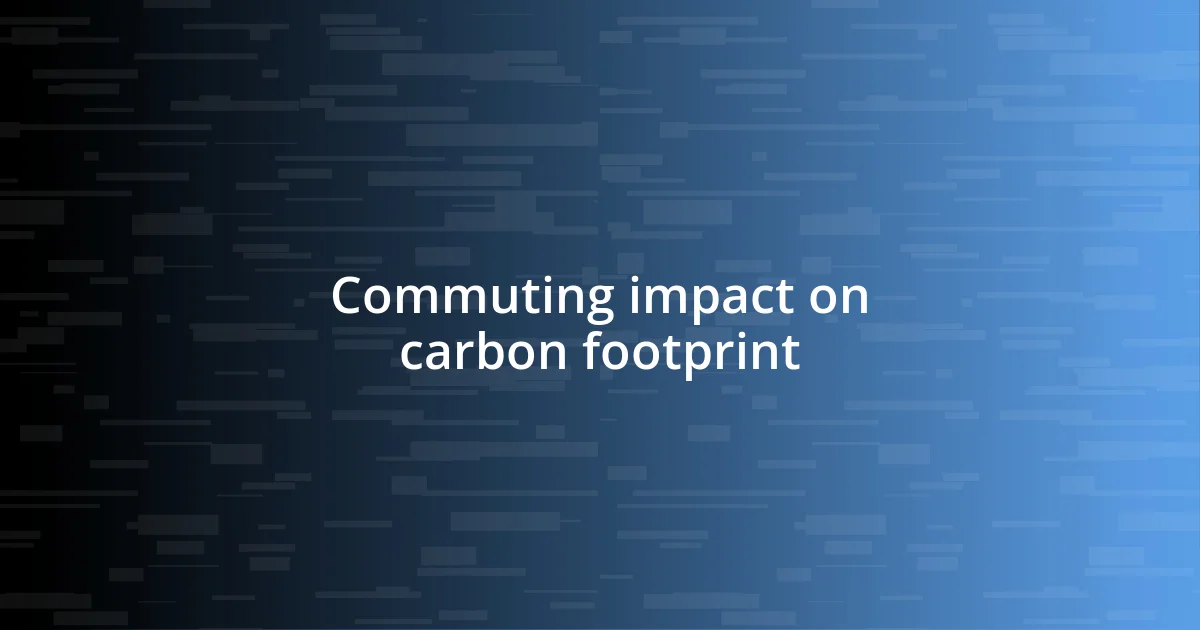Key takeaways:
- Tracking daily commuting habits revealed significant contributions to personal carbon footprints, highlighting the cumulative impact of seemingly minor trips.
- Shifting to alternative transportation methods, like cycling or utilizing public transport, not only reduces emissions but also enhances personal well-being and energy levels.
- Engaging in carpooling and moving to electric vehicles facilitate lower emissions and foster community connections, proving that small changes can lead to substantial benefits.

Understanding carbon footprint basics
Understanding carbon footprint basics begins with recognizing that it represents the total amount of greenhouse gases, like carbon dioxide, that are emitted directly or indirectly through our daily activities. Think about the last time you hopped in your car for a short drive; how often do we consider the impact of that convenience on the environment? It’s surprising how those seemingly insignificant trips can add up over time.
I remember the moment I realized just how much my daily commute affected my carbon footprint. One day, I decided to track my emissions from just commuting to work for a week. I was shocked to discover that my car trips contributed a significant portion to my overall carbon output. It really hit home how our everyday choices, like the mode of transportation we choose, can cumulatively impact the planet.
Carbon footprints can be complex, as they are influenced by various factors including the energy sources we rely on and the types of transportation we use. Have you ever thought about how public transport versus a personal vehicle impacts your emissions? For instance, switching to biking or taking the bus can drastically reduce your footprint, not to mention the added health benefits that come from being active. It’s a small change that can lead to significant results if we all play our part.

Commuting impact on carbon footprint
The way we commute has a profound impact on our carbon footprint. Every time I hopped into my car, the convenience felt great, but the realization of how those trips pieced together in terms of emissions was a wake-up call. It often struck me that even short commutes, which I initially brushed aside, could contribute considerable greenhouse gases—making it essential for me to reconsider my transportation choices.
I recall a time when I switched to cycling for my daily commute. Not only did I cut down my carbon emissions significantly, but I also felt a surge of vitality with every pedal stroke. It’s amazing how embracing a greener transportation method can transform not just your environmental impact but also your overall well-being. Have you experienced that rush of freshness from biking? It’s like two benefits in one—reducing your footprint while invigorating your mind and body.
When reflecting on commuting options, I often weigh personal vehicles against public transport. While my car offered comfort, it was a humbling experience to realize that buses and trains, which facilitate shared travel, dramatically lower individual emissions. The choice between convenience and collective responsibility can sometimes be tough, but I find that every journey provides a chance to make environmentally conscious choices that truly matter.
| Transportation Method | Carbon Emissions (grams per mile) |
|---|---|
| Personal Car | 404 |
| Public Bus | 68 |
| Bicycle | 0 |
| Walking | 0 |

Evaluating public transport options
When evaluating public transport options, I’ve found that not all systems are created equal. In my experience, the availability and efficiency of local transit can greatly affect the decision to switch from a personal vehicle. One rainy afternoon, I took the bus for the first time in ages, and it was eye-opening. Although I initially hesitated due to scheduling uncertainties, I quickly realized how relaxing it was not to have to navigate traffic. I felt oddly liberated, allowing me to read and unwind—all while contributing to a lower carbon footprint.
Here’s a concise look at what I consider when weighing public transport:
- Reliability: Are the buses and trains running on time?
- Frequency: How often do they arrive, especially during peak hours?
- Coverage: Does the network provide access to key destinations?
- Affordability: Is the fare reasonable compared to driving costs?
- Comfort: How does the ride quality compare with driving?
By noting these factors, I’m able to better understand how public transport can align with my commitment to reducing emissions. It feels rewarding to choose options that are not only budget-friendly but also kinder to the planet.

Choosing a bicycle for commuting
Choosing the right bicycle for commuting can be a personal journey. I remember the day I stepped into a local bike shop, overwhelmed yet excited. The options were endless—road bikes, hybrid bikes, and even electric models. After trying a few, I quickly discovered that comfort and fit were paramount. You want to be able to hop on for that early morning ride without feeling like you’re contorting your body into an awkward position. Who wants a sore back while trying to enjoy the ride to work?
As I delved deeper into the world of cycling, I found that features like gear ratios and tire width really made a difference in my daily commute. For instance, switching to a bike with wider tires not only provided better stability on uneven roads but also gave me the confidence to tackle those unexpected potholes. It’s those little adjustments that help make each ride smoother and more enjoyable. Have you ever pedaled through a particularly bumpy path and wished for a more capable bike? Choosing wisely can truly enhance your experience.
I also learned the importance of accessories that promote safety and convenience. Investing in a good helmet became a no-brainer after my first ride on a busy road. I found that having bright lights and reflective gear not only safeguarded me but also boosted my confidence. Isn’t it fascinating how a few thoughtful choices can transform an ordinary bike ride into a reassuring and exhilarating experience? Choosing the right bike is not just about making a purchase; it’s about embracing a new lifestyle that empowers you every single day.

Carpooling strategies for reduction
Carpooling can feel daunting at first, but I’ve found it immensely rewarding. One strategy that worked for me was coordinating with colleagues who live nearby. After sending out a quick group message, we established a rotating schedule, and I was surprised at how quickly we turned what seemed like a logistical nightmare into a cheerful morning routine. Have you ever shared your ride and found that the conversations can make the commute much more enjoyable? They can even turn mundane traffic into an opportunity for laughter and connection.
Another effective approach I’ve used is leveraging social media platforms or local apps specifically designed for carpooling. I remember the first time I joined such a group—I was nervous about meeting strangers. However, it ended up being a great decision. Not only did I reduce my fuel costs, but I also made new friends and expanded my local network. It’s incredible how technology can facilitate these connections and foster a sense of community. Have you thought about ways to connect with others in your area?
Lastly, I’ve discovered that setting clear rules and communication channels among carpoolers is crucial. In my first few weeks of carpooling, I learned that discussing pickup times and responsibilities upfront eliminates misunderstandings. One time, we had a miscommunication about who was driving, resulting in a scramble that almost made me miss an important meeting. Since then, we’ve created a simple group chat where we can update each other in real-time. This little adjustment transformed our commute from a source of stress to something I genuinely look forward to. Isn’t it amazing how small changes can lead to big improvements in our experiences?

Shifting to electric vehicles
Making the shift to an electric vehicle (EV) was a game changer for me. I still remember the first time I drove my EV—it felt like stepping into the future. The smooth drive and whisper-quiet engine made my daily commute not just eco-friendlier but also surprisingly enjoyable. Have you experienced that exhilarating burst of instant torque? It’s thrilling, and it almost makes you forget you’re reducing your carbon footprint!
I dove into the benefits of charging options, which was enlightening. Initially, I was worried about range anxiety, the fear of running out of battery while out and about. But with home charging and the availability of public charging stations, I found it to be less of a concern over time. One moment that stood out was when I was out with friends, and while they were searching for gas stations, I casually plugged in my car to charge at a café. It felt liberating not to have to stop and wait in line for gas. Have you thought about how EVs can fit seamlessly into your routine?
Owning an electric vehicle also influenced my lifestyle choices in unexpected ways. For instance, I’ve become more conscious of where I park; finding a spot with chargers suddenly became part of my routine. Even the act of charging my car—like an electric version of filling up at the pump—has become a moment of reflection for me. Sometimes, I’ll sit and enjoy a coffee while my car powers up, taking that time to unwind between responsibilities. Doesn’t it feel good to incorporate habits that not only benefit you but also the planet? I believe shifting to EVs can enrich our lives while making a positive impact on the environment.

Tracking progress and making adjustments
Tracking my progress on reducing my carbon footprint while commuting has been an eye-opening experience. I started by keeping a simple log of my travel methods each week, noting how often I carpooled, took public transport, or used my electric vehicle. It was fascinating to see my habits visually mapped out—it made the invisible impact of my choices painfully clear! Have you ever tried tracking your routines? You might be surprised by the patterns you uncover.
As months went by, I recognized the need to fine-tune my approach. For example, I realized that using a bike for short trips not only cut down my carbon emissions but also gave me an energy boost. I remember the first day I decided to bike to a nearby coffee shop instead of driving; the fresh air and exercise left me feeling invigorated, and I was more productive for the rest of the day. I even found myself pondering why I hadn’t embraced this healthier option sooner. Have you looked for similar opportunities in your own commuting habits?
Reflection is key to making successful adjustments. I often dedicated a few minutes each month to assess what worked and what didn’t. If I had weeks where my public transport use dipped, I’d ask myself why. Perhaps it was due to schedules that didn’t align or a lack of motivation. These moments of introspection helped me stay committed to my goals. Sometimes, it’s these simple yet critical checkpoints that can reignite your passion for change, don’t you think?














